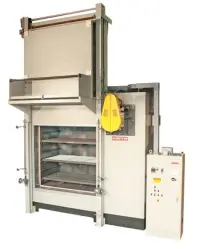Binder Burnout Furnaces and Debinding Ovens
Ceramic powders are often mixed with organic binders suited for the shaping process. In addition, various solvents and lubricants are included to aid in pressing or extruding. These binders need to be removed slowly from the green parts prior to the sintering process.
The rate at which organics are removed from a ceramic work piece is highly dependent upon the individual organic being used as well as the mechanical nature of the ceramic materials being processed. Ultimately, the goal of debinding is to control the rate of binder removal so as not to cause stresses within the part, and to avoid sealing the surface of the part prior to completion of the binder material removal process. Heating with poor uniformity or too fast will often result in flaws within the finished part. This phenomenon, known as “black core” occurs when carbon residue of the binder decomposition is trapped in the interior or the ceramic and affects the strength or appearance of the product. This problem is not limited to a binder process; it is also common in the firing of ceramics made with naturally obtained clays due to organics (the most common being lignite) present in the silt deposited in eons past which is mined today as clay.
In some oxide and nitride ceramics, organic binders can be removed in refractory-lined furnaces in air; other compositions may require inert or reducing atmospheres. Binders are usually converted from a solid to a gas below 600°C, where they form volatiles which need to be abated by oxidation to satisfy environmental requirements. This is done in afterburners, thermal oxidizers or catalytic oxidation systems which must be carefully integrated into the furnace design so their performance doesn’t impact the precise temperature control of the furnace.
Removing binders (debinding) requires a convection heating system with a high rate of circulation of the atmosphere with slow rates of temperature rise during the debinding phase. The rates of heating and the required level of uniformity are functions of the vaporization dynamics of the volatiles in use.
Some commonly used binders are methyl cellulose, Polyvinyl Alcohol (PVA) and Polyvinyl Butyral (PVB) and a whole host of naturally occurring oils, starches and sugars. Each binder or combination of binders requires tailored heating profiles.
The debinding process has some inherent dangers that must be properly addressed in the design of the debinding furnace; specifically, the system must be designed to prevent creation of a mixture of air and organics that could possibly ignite or combust at the process temperature. This is most often addressed by providing sufficient fresh air to the process to insure that the organic fuel and air mixture stays well below the “lower flammability limit,” typically around 20% of the LFL value, and limiting the rate of temperature increase to ensure that volatiles are produced at a limited rate.
Another issue that must be addressed in debinding furnaces is the tendency for the products of organic decomposition to condense onto cool surfaces as tars and oils, creating both maintenance issues and safety hazards. For this problem, the equipment builder can either ensure that concentrations of all the volatiles stay sufficiently below their room temperature dew-points or, more practically, are maintained at a temperature above their dew point until they reach the thermal abatement system. Since keeping dew-point low involves large volumes of dilution air which must then be heated in the process, properly insulating the ducts between the process and the abatement becomes the more economical and attractive solution.
Many of Keith Company’s products are available with integral process features that will allow debinding and sintering in the same furnace. The organic laden exhaust is routed to an integrally installed thermal oxidation system. This approach yields a single machine solution to what has in the past been a complex problem requiring multiple machines and process steps. Keith has the know-how and experience to use Thermal-Gravimetric Analysis (TGA) test data for the binder materials to design and ensure a safe and successful process.
Furnace Types:
- Atmosphere furnace
- Debinding furnace/oven
- Tunnel kilns
- Envelope kilns
- Shuttle kilns
Contact Keith Company to order the debindering furnace your application requires, or to learn more about any of our products.






